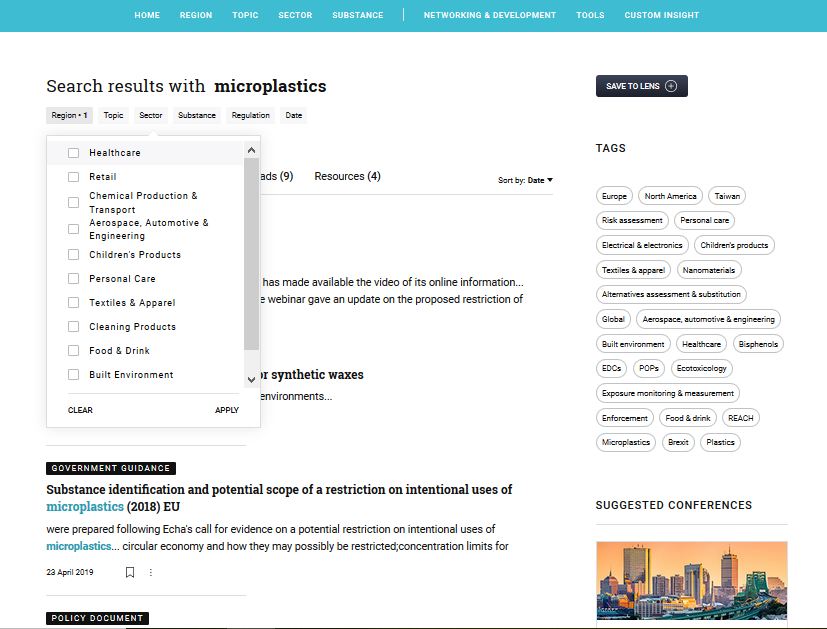By partnering with 67 Bricks to implement this strategic capability, we are now well positioned to meet our customers’ needs, now and in the years ahead. – Richard Butterworth, Commercial Director, Chemical Watch
Headline wins
- 40% increase in repeat revenues
- Increased company value leading to acquisition by Enhesa
- New product development made significantly easier to deliver
The brief
In 2007, the introduction of the EU’s REACH regulations had a profound impact on businesses involved in chemicals. Recognizing the need for proactive chemical compliance, Julian Rose and Mamta Patel established Chemical Watch, providing a comprehensive hub for compliance news, analysis, events, and training.
A decade after its inception, the company sought to adapt to changing customer demands. With a growing focus on data-driven decision-making, improved user experiences, and a competitive landscape of information sources, Chemical Watch partnered with technology firm 67 Bricks to innovate further and cement their position as an essential provider of vital and unique business intelligence.
Product development discovery with 67 Bricks
The challenge was to optimize content for enhanced member value and an improved customer experience. The project started with a short discovery phase during which 67 Bricks analysed existing Chemical Watch data and content, ran workshops with stakeholders and developed a clear view of the product features that technology could enable in the short, medium and long term. The team then carried out extensive customer research so their needs informed the user stories, UX and UI design process.
Innovation powered by semantic fingerprinting
Drawing on insights from this discovery work, the team recognised the importance of timely regulatory insights, personalized user experiences, and advanced warnings of developments. They set to work on implementing semantic fingerprinting to enable content and users to be matched together in unique and useful ways. This would then drive multiple product features such as the display of related content, improved content notifications, in-line links to further information, taxonomic browsing, faceted search, content collections and semantic search. Chemical Watch are able to fingerprint not just news articles, but any type of content a user might be interested in – events, jobs, webinars, third-party pdfs, conference presentations – unlocking significant value.
Results
The strategic collaboration yielded substantial outcomes:
-
- Increased revenue: The enhanced content capabilities and improved user experience led to the successful relaunch of Chemical Watch’s new, higher-value service offering with improved search, discovery and personalisation, resulting in a 40% increase in repeatable revenues.
- Personalised user experiences: End-customers can now build their own personal and work team custom feeds, drawing on enriched editorial content as well as data from external sources.
- Future-proof content enrichment: By implementing semantic fingerprinting, Chemical Watch successfully enriched its content with comprehensive metadata. This powers personalized user experiences, advanced content notifications, related content displays, and tailored search options. This transformation promoted efficient information retrieval and enabled Chemical Watch to proactively pursue third-party integration and data licensing opportunities.
- New possibilities for future innovations: Leveraging semantic fingerprinting, Chemical Watch is poised for future innovations. They envision products like a substance tracker, which would assist customers in tracking chemicals used in their products to mitigate risks. Additionally, the technology could streamline internal operations, such as content tagging, news identification, trend spotting, and automated marketing efforts.
- Increased corporate value: The adoption of this new technology increased the company’s overall value. As a result, it was acquired by an international EHS information organisation (Enhesa). The system is currently being expanded and used to enrich a far larger body of data and content.
Chemical Watch’s evolution to a sophisticated data-driven platform showcases their commitment to delivering value to customers as a future-focused small business providing the best service to the market. This proactive mindset has led to substantial revenue growth and product innovation.
Looking to the future, transforming content into a data asset means Chemical Watch can build on this success and deliver innovative products and services that meet the needs of their customers both now and in years to come.








